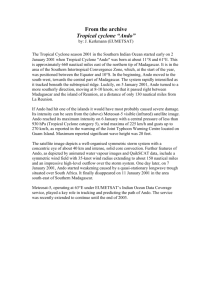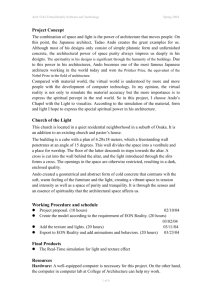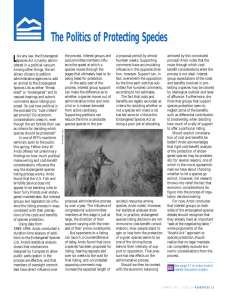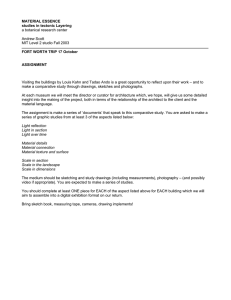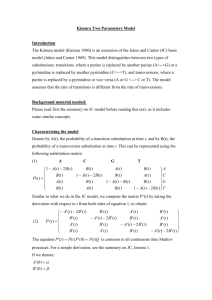The Economic Analysis of International Production/Distribution Networks
advertisement
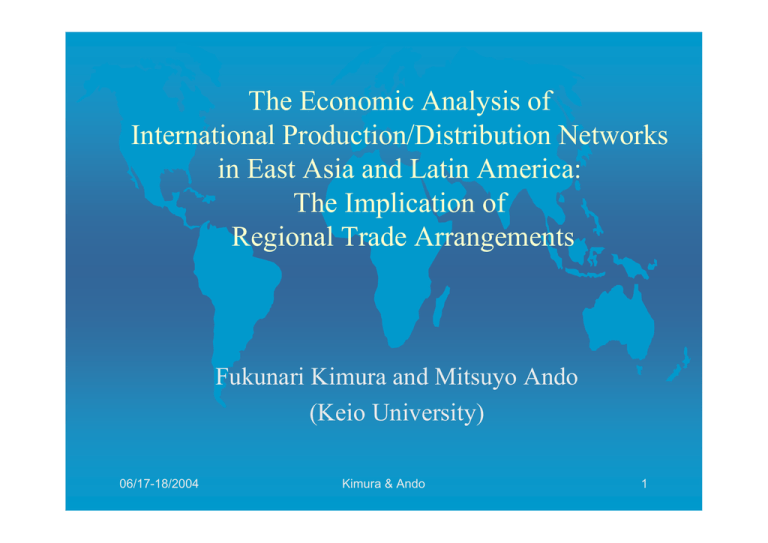
The Economic Analysis of International Production/Distribution Networks in East Asia and Latin America: The Implication of Regional Trade Arrangements Fukunari Kimura and Mitsuyo Ando (Keio University) 06/17-18/2004 Kimura & Ando 1 1. FTAs and FDI z Motivation for concluding FTAs by LDCs – Market access to DCs’ market (classic) – Stimulating inward FDI (wave of globalization) z z FDI: a bundle of capital, technology, manegerial ability, access to foreign markets, and others Development strategies: EA vs. LA – EA: dual-track approach, formation of International production/distribution networks in the 1990s – LA (except Mexico): FDI is still import-subst.-type z Implication for the design of FTAA? 06/17-18/2004 Kimura & Ando 2 2. The formation of international production/ distribution networks z Unprecedented formation of International prod./dist. networks in EA – Vertical chains of production + world-wide distribution network – Major players: firms in machinery industries z Economic logic – Traditional trade theory of comparative advantage z Wages, technology transferability – New lines of thought z z z 06/17-18/2004 Fragmentation theory Agglomeration theory Internalization theory of “firm” Kimura & Ando 3 Figure 1 Fragmentation Before fragmentation upstream downstream After fragmentation PB SL SL PB PB PB SL 06/17-18/2004 SL PB Kimura & Ando SL PB: production block SL: service link 4 Figure 2 Agglomeration or industrial clusters Economies of scale in the spatial version “Agglomeration makes agglomeration” 06/17-18/2004 Kimura & Ando 5 Figure 3 Internalization and location decisions Upstream An example: Basic parts Modules Assembly (OEM) Wholesales Downstream 06/17-18/2004 Kimura & Ando 6 Networks in East Asia z Distinctive features – Significance in each country’s economy – Extensiveness covering a number of countries – Sophistication including intra-firm and arm’s-length transactions (including those b/w different firm nationalities) – cf. US-Mexico, Germany-Czech/Hungary z Background – “Accept everybody” policy to aggressively utilize FDI – Policy package to reduce service link costs and create a critical mass of agglomeration 06/17-18/2004 Kimura & Ando 7 % Figure 4 Machinery goods and the parts and components: shares in total exports and imports in 2000 80 Philippines Singapore Malaysia Japan 70 Korea U.S.A. Thailand 60 Mexico Hong Kong 50 China 40 Brazil Argentina Indonesia Colombia Chile Honduras Venezuela 30 Guatemala Peru Ecuador 20 10 PH IL I SI P PI NG NE A S M PO A LA RE YS JA IA P H AN un ga r U. y S. K A. TH OR AI EA LA N HO C D NG z e c K h ON G U. M K. e Ge xico rm an Fr y an c Po e lan Ca d n Sl ada ov ak CH ia IN Es A to ni IN B a DO r a NE zil Li SIA th u Ar a ni ge a nt in a In di La a tv Ru ia Co s sia lo m bi a Ch H i l on e d V ur a en s e Gu zue ate la m ala P Ec eru ua do r 0 Exports: machinery goods Exports: parts and components in machinery goods 06/17-18/2004 Imports: machinery goods Imports: parts and components in machinery goods Kimura & Ando 8 3. Differences in investment pattern: EA vs. LA z z EA vs. LA: about the same economic size, however, far from EA investors Observation from micro data of Japanese firms – The number of affiliates, weights of manufacturing, machinery industries (Table 1) – FDI by SMEs (Table 2) – “Sector switching” pattern (Table 3) – Intra-regional sales and purchases (Table 4) – Firm nationality approach (Figure 5) – In EA, international prod./dist. networks are actively utilized. In LA, no evidence on the existence of such networks (except US-Mexico). 06/17-18/2004 Kimura & Ando 9 Table 1 Japanese Parent Firms and Their Foreign Affiliates by Industry (excerpt) By industry of affiliate By industry of parent firm By industry of parent firm # of parent firms Industry # of % affiliates % # of affiliates (a) Parent firms with affiliates in East Asia Manufacturing 2050 68 6296 62 6082 Non-machinery sectors 1038 35 2910 28 3198 Machinery sectors 1012 34 3386 33 2884 % 59 31 28 # of parent firms # of % affiliates By industry of affiliate # of affiliates % (b) Parent firms with affiliates in Latin America 197 68 385 35 286 90 31 157 14 136 107 37 228 21 150 26 12 14 % 290 286 10 810 8 543 5 32 11 58 5 36 3 300 429 14 1598 16 1475 14 35 12 94 8 68 6 310 222 7 752 7 664 6 31 11 65 6 40 4 320 75 3 226 2 202 2 9 3 11 1 6 1 944 32 3928 38 4142 41 91 32 725 65 824 74 Non-manufacturing 480 Others 697 23 3350 33 247 8 578 6 Total 2994 100 10224 100 79 54 % in total foreign affiliates 06/17-18/2004 2627 26 1515 15 10224 100 54 Kimura & Ando 73 25 18 6 288 100 8 700 63 25 2 1110 100 6 308 28 516 46 1110 100 6 10 Table 2 Foreign affiliate ownership patterns of Japanese parent firms (number of parent firms) # of regular workers of parent Firm 50 to 99 100 to 199 200 to 299 300 to 499 500 to 999 1,000 and more Total 50 to 99 100 to 199 200 to 299 300 to 499 500 to 999 1,000 and more Total 06/17-18/2004 1 301 413 196 242 209 136 1497 15 15 6 22 27 89 174 2 67 101 92 99 117 107 583 1 2 3 5 2 37 50 3 25 34 30 36 65 77 267 . . 1 4 Number of affiliates 5 6 7 8 9 12 23 12 28 42 54 171 in East Asia (2000 F/Y) 1 2 1 . 7 1 2 . 8 10 3 2 18 8 6 4 27 20 5 2 55 45 27 38 116 86 44 46 . 2 1 2 4 16 25 . . . . 2 19 21 in Latin America (1995 F/Y) . . . . . . . . 1 . . . . . . . 2 . . . . . . . . 1 . . . . . . . . . 1 1 2 3 10 10 . . . . . 2 22 23 5 7 . 7 10 7 7 Kimura & Ando 2 2 1 1 10 More Total 1 410 . 583 1 355 4 447 10 503 122 696 138 2994 % 13.7 19.5 11.9 14.9 16.8 23.2 100.0 17 5.9 17 5.9 11 3.8 29 10.1 31 10.8 183 63.5 288 100.0 11 Table 3 Sector switching between parent firms and their affiliates (a) Industries of Japanese parent firms and their affiliates in East Asia, 2000 F/Y (number of affiliates in East Asia) Industry of affiliate in East Asia Industry of parent firm 120 130 140 150 160 170 180 190 200 210 220 230 240 250 260 270 280 290 300 310 320 340 480 Others 120 130 140 150 160 170 180 190 200 210 220 230 240 250 260 270 280 290 300 310 320 340 480 Other 145 1 2 20 15 5 28 12 19 10 70 7 2 2 1 2 2 10 0 5 73 2 2 1 12 1 14 1 1 2 0 2 25 1 8 0 45 2 1 5 3 63 1 6 4 7 9 2 43 4 1 1 3 520 3 15 2 4 4 7 6 8 1 3 10 174 47 2 2 4 1 9 18 7 184 6 1 1 2 2 8 1 5 33 4 1 1 3 89 2 1 4 1 3 15 8 6 1 0 1 1 4 87 1 7 1 3 1 4 2 21 26 1 51 3 10 2 8 4 7 29 1 2 1 1 161 14 3 30 14 2 30 23 1 1 2 1 4 2 14 161 7 27 5 1 8 34 9 4 10 4 1 8 1 15 362 65 20 18 15 214 73 2 2 1 1 5 12 5 1 3 6 79 1009 6 17 9 308 132 1 2 2 5 9 22 25 569 3 59 55 1 2 1 3 1 6 14 131 56 11 1 1 10 1 2 2 3 66 48 11 115 11 83 157 13 8 14 9 142 11 60 22 3 70 47 32 63 39 266 34 22 56 1516 557 5 0 1 15 6 1 1 0 4 1 2 0 2 2 1 2 4 12 7 3 1 9 23 476 284 43 208 258 38 37 63 80 709 17 313 121 11 179 113 222 303 543 1475 664 202 199 2627 1515 06/17-18/2004 Kimura & Ando 12 Total 183 74 96 96 18 36 56 81 867 36 254 128 7 159 115 282 277 810 1598 752 226 145 3350 578 10224 (b) Industries of Japanese parent firms and their affiliates in Latin America, 1995 F/Y (number of affiliates in Laitn America) Industry of affiliate in Latin America Industry of parent firm 120 130 140 150 160 170 180 190 200 210 220 230 240 250 260 270 280 290 300 310 320 340 480 Others 120 130 140 150 160 170 180 5 1 2 9 2 3 1 1 190 200 210 220 230 240 250 260 270 280 290 300 310 320 1 2 4 6 18 2 1 1 1 5 3 1 11 1 1 26 5 1 1 46 2 1 33 3 13 22 1 4 7 24 06/17-18/2004 3 6 3 10 1 2 3 3 6 2 26 1 1 1 3 1 0 Kimura & Ando 1 4 3 3 9 7 15 2 2 36 21 4 68 40 1 1 6 340 480 Other Total 5 10 21 1 9 13 1 1 11 5 1 2 1 3 3 2 5 8 43 7 3 10 1 1 0 0 1 3 1 1 5 13 2 6 1 6 18 17 12 58 33 8 94 11 19 65 5 3 11 2 3 5 217 407 700 18 25 3 308 516 1110 13 Table 4 Intra-regional production networks: sales and purchases by Japanese affiliates in East Asia, 1998 F/Y (excerpt) Industry Number of affiliates % (a) East Asia Manufacturing Sector 120+130 162 2.6 140+150 399 6.4 160 23 0.4 170 14 0.2 180 36 0.6 190 27 0.4 200 529 8.5 210 17 0.3 220 109 1.8 230 54 0.9 240 16 0.3 250 160 2.6 260 166 2.7 270 110 1.8 280 121 1.9 290 315 5.1 300 916 14.7 310 478 7.7 320 100 1.6 330+340 83 1.3 Manufacturing total Non-Manufacturing Sector 050 11 0.2 480 957 15.4 540 170 2.7 Others 1240 20.0 Total 6213 100.0 06/17-18/2004 Share in total sales (%) Local Japan Third countries (Total) East North Europe Latin Asia America America Share in Total Purchases (%) Local Japan Third countries (Total) East North Europe Latin Asia America America 69 44 15 53 74 78 70 21 65 41 5 70 85 56 71 32 32 81 27 22 49 16 30 56 34 12 0 7 66 20 34 21 17 3 16 13 41 33 11 46 64 25 15 26 28 13 13 22 24 13 15 24 74 13 12 29 16 27 35 8 27 14 25 6 12 24 9 9 12 16 3 10 13 22 9 7 26 12 15 25 2 23 3 17 3 5 1 4 4 0 5 0 2 5 44 4 3 1 2 5 5 3 2 7 5 4 7 0 0 0 5 2 10 3 5 8 1 0 1 1 5 3 1 2 3 3 0 0 0 0 1 0 0 0 0 0 0 0 2 0 0 0 1 0 0 0 0 79 54 94 75 62 74 54 22 68 57 10 41 19 44 68 58 36 53 40 55 43 7 27 3 14 21 17 19 18 26 24 7 32 70 32 29 32 37 37 41 38 35 15 19 3 11 17 10 27 60 6 19 83 27 11 24 3 10 27 9 19 7 22 8 13 0 8 14 0 13 45 5 17 41 23 10 19 2 9 26 6 14 6 19 0 2 0 0 2 2 7 10 0 0 10 3 0 0 0 1 0 2 3 0 2 0 1 3 3 1 8 2 4 1 2 3 0 0 1 1 0 0 1 1 1 1 2 0 0 0 0 0 0 0 0 0 6 0 0 0 0 0 0 0 0 0 0 33 41 88 70 67 19 6 15 0 39 6 15 0 33 5 10 0 2 0 3 0 3 0 2 0 0 0 0 98 28 75 71 2 35 21 18 0 36 4 11 0 28 1 9 0 2 2 0 0 3 0 1 0 1 0 0 50 22 28 21 3 3 0 41 33 25 21 1 1 0 Kimura & Ando 14 Number Industry of affiliates % (b) Latin America Manufacturing Sector 120+130 11 1.4 140+150 30 3.7 160 6 0.7 180 2 0.2 200 23 2.8 210 2 0.2 220 2 0.2 250 6 0.7 260 9 1.1 270 4 0.5 280 4 0.5 290 24 3.0 300 69 8.5 310 62 7.7 320 6 0.7 330+340 8 1.0 Manufacturing total Non-Manufacturing Sector 050 22 2.7 480 160 19.8 540 15 1.9 Others 344 42.5 Total 809 100.0 06/17-18/2004 Share in total sales (%) Local Japan Third countries (Total) East North Europe Latin Asia America America Share in Total Purchases (%) Local Japan Third countries (Total) East North Europe Latin Asia America America 79 86 28 10 88 96 100 24 97 24 100 75 79 83 83 50 71 9 6 23 38 0 4 0 2 3 29 0 2 5 0 1 45 8 12 8 49 53 12 0 0 75 0 48 0 23 16 16 16 5 21 0 0 3 4 0 0 0 0 0 2 0 1 0 0 0 0 1 2 5 31 13 3 0 0 75 0 17 0 17 13 13 4 5 12 7 0 3 31 0 0 0 0 0 29 0 3 1 0 3 0 6 1 2 4 4 8 0 0 0 0 0 0 1 2 3 9 0 2 100 68 100 0 72 87 95 16 38 86 52 58 46 39 45 16 54 0 3 0 0 6 2 5 14 43 0 27 28 33 49 39 27 29 0 30 0 0 22 12 0 71 20 14 21 14 21 12 16 57 17 0 1 0 0 0 0 0 12 2 0 0 0 14 1 16 0 5 0 14 0 0 21 12 0 58 18 14 21 8 2 9 0 57 8 0 0 0 0 1 0 0 0 0 0 0 5 4 2 0 0 2 0 9 0 0 1 0 0 0 0 0 0 0 0 0 0 0 0 8 69 100 41 63 37 7 0 35 12 55 24 0 24 26 20 0 0 3 3 5 2 0 2 7 16 1 0 17 5 13 21 0 1 11 86 24 56 47 39 0 51 31 40 40 14 25 13 13 21 0 4 0 3 4 14 15 13 3 12 0 0 0 2 1 0 5 0 4 3 Kimura & Ando 15 Figure 5 Japanese value added embodied in sales to Asians and foreigners by Japanese: three-country setting (2000) (Unit: million JPY) Japan JAFF owned by Asians (Asians) JAFF owned by foreigners (Foreigners) Japanese-owned firms (Japanese) Value added in exports by Japanese in Japan: 42,132,623 3,132,287 10,710,170 21,084,637 7,205,530 Foreigners Asians FAJFs Total VA: 8,054,035 ROW 2,475,695 1,611,093 FAJFs 83,975 Foreigners Total VA: 27,905,073 Asians Asia 310,082 19,723,339 3,613,841 465,123 06/17-18/2004 2,409,228 4,930,835 335,899 Kimura & Ando 16 3. Differences in investment pattern: EA vs. LA (conti.) z Evidence from the US-BEA data on US MNEs – Heavier weights on non-manufacturing (Table 5) – Weights of manufacturing, machinery industries (Table 6) – By-destination sales (Table 7) – Similar to Japanese firms in that they utilize international prod./dist. networks in EA, and do not in LA. 06/17-18/2004 Kimura & Ando 17 Table 5 U.S. parent firms and majority-owned non-bank foreign affiliates by industry, 1999 F/Y Industry Manufacturing sector Non-machinery sectors Machinery sectors By industry of parent firm Number of Number of % parent firms affiliates 1300 54 13541 746 31 7709 554 23 5832 By industry of affiliate % 64 36 28 Number of affiliates 7601 4744 2857 % 36 22 14 Machinery 169 7 1428 7 885 4 Computer and electronic products 235 10 1781 8 878 4 Electrical equipment, appliances etc. 56 2 676 3 308 1 Trasnport equipments 94 4 1947 9 786 4 1109 262 847 2409 46 11 35 100 7598 1613 5985 21139 36 8 28 100 13538 4907 8631 21139 64 23 41 100 Non-manufacturing sector Wholesale trade Others Total 06/17-18/2004 Kimura & Ando 18 Table 6 Sales and gross products by U.S. majority-owned non-bank affiliates in East Asia and Latin America by industry East Asia (2846) Value (a) Sales (million US$) Manufacturing Non-machinery sectors Machinery sectors Machinery Computer and electronic products % Latin America excl. Brazil and Mexico (2078) Total (3403) Value % Value Share of Brazil and Mexico % 112,036 33,479 78,557 47.9 14.3 33.6 130,977 73,155 57,822 53.3 29.8 23.5 35156 29152 6,004 31.7 26.3 5.4 73.2 60.2 89.6 3,781 1.6 7,342 3.0 285 0.3 96.1 68,613 29.4 14,382 5.9 1456 1.3 89.9 Electrical equipment, appliances, etc. 2,747 1.2 2,747 1.1 234 0.2 91.5 Transport equipments 3,416 1.5 33,351 13.6 4029 3.6 87.9 Non-manufacturing Wholesale trade Others 121,656 75,337 46,319 52.1 32.2 19.8 114,592 40,422 74,170 46.7 16.5 30.2 75,839 28080 47759 68.3 25.3 43.0 33.8 30.5 35.6 Total 233,692 100.0 245,569 100.0 110995 100.0 54.8 22,079 8,938 13,141 44.0 17.8 26.2 33,833 23,164 10,669 57.0 39.0 18.0 9120 8080 1,040 34.9 30.9 4.0 73.0 65.1 90.3 (b) Gross products (million US$) Manufacturing Non-machinery manufacturing Machinery sectors Machinery 1,042 2.1 2,220 3.7 71 0.3 96.8 10,628 21.2 1,069 1.8 232 0.9 78.3 Electrical equipment, appliances, etc. 648 1.3 805 1.4 59 0.2 92.7 Transport equipments 823 1.6 6,575 11.1 678 2.6 89.7 Non-manufacturing Wholesale trade Others 28,067 7,636 20,431 56.0 15.2 40.7 25,528 5,568 19,960 43.0 9.4 33.6 17,000 3869 13131 65.1 14.8 50.3 33.4 30.5 34.2 Total 50,146 100.0 59,361 100.0 26120 100.0 56.0 Computer and electronic products 06/17-18/2004 Kimura & Ando 19 Table 7 By-destination sales by U.S. majority-owend non-bank affiliates (excerpt) # of affiliate s Local East Asia 2846 56.2 (8.1) 17.1 Latin America Mexico Brazil 3403 799 526 65.8 64.0 83.9 (7.6) (12.5) (3.0) 17.5 27.4 5.8 06/17-18/2004 U.S. other U.S. affilaites Share in total sales (%) Third countries (Total) U.S. parent other U.S. East firms affilaites Asia (87.0) 26.7 (59.4) 17.1 (88.0) (91.1) (85.6) Kimura & Ando 16.8 8.6 10.2 (57.5) (72.5) (60.3) 2.3 1.0 0.3 Europe Latin America n.a. 0.9 5.4 1.7 3.6 7.8 4.5 5.9 20 4. The assessment of investment climate z JBIC survey (Tables 8, 9) – China and other EA: great FDI attractor – Attractive factors: market, labor, agglomeration, fragmentation – Impediments: infrastructure, transparency, fairness, predictability z Business costs and governance indicators (Table 10) – EA dominates LA in most of the indicators z “Complaints” on LA by Japanese firms (BCFTI) (Table 11) – Re: RTAs, uncertainty and instability in policies 06/17-18/2004 Kimura & Ando 21 Table 8 Prospective destination countries for Japanese FDI (excerpt) 2001 F/Y 2002 F/Y Number Number Destination country of firms Destination country of firms (a) Short run (incoming 3 years) 401 100% 418 100% 1 China 327 82% 1 China 373 89% 2 United States 127 32% 2 Thailand 118 28% 3 Thailand 99 25% 3 United States 108 26% 4 Indonesia 56 14% 4 Indonesia 63 15% 5 India 52 13% 5 Vietnam 62 15% 6 Vietnam 48 12% 6 India 54 13% 7 Taiwan 44 11% 7 Korea 34 8% 8 Korea 33 8% 7 Taiwan 34 8% 9 Malaysia 32 8% 9 Malaysia 33 8% 10 Singapore 24 6% 10 Brazil 19 5% 11 The Philippines 22 5% 11 Singapore 18 4% 12 Germany 19 5% 12 The Philippines 17 4% 13 Brazil 18 4% 13 Germany 16 4% 13 Mexico 18 4% 14 Mexico 15 4% 15 France 17 4% 15 Czech 13 3% 16 Czech 15 4% 16 United Kingdom 11 3% 17 United Kingdom 14 3% 16 Russia 11 3% 18 Hungary 12 3% 18 Poland 10 2% 19 Poland 11 3% 19 Hong Kong 9 2% 20 Hong Kong 8 2% 19 Hungary 9 2% 06/17-18/2004 Kimura & Ando 22 Table 9 Prospective destination countries for Japanese manufacturing FDI: their strong and weak points Ranking 1 2 3 4 5 6 7 Country China Thailand U.S. IndonesiaVietnam India Korea (a) Strong points 112 108 61 54 50 32 Number of firms1) 373 7 9 10 Taiwan Malaysia Brazil 32 30 19 Market potential 86.3 54.5 39.8 47.5 55.6 84.0 53.1 53.1 33.3 73.7 Inexpensive labor 68.9 48.2 0.9 73.8 70.4 60.0 12.5 15.6 40.0 26.3 To supply intermediate goods for assemblers 28.7 33.0 26.9 21.3 9.3 16.0 25.0 37.5 23.3 26.3 Present market size 17.2 9.8 62.0 9.8 1.9 14.0 28.1 43.8 10.0 10.5 To export to the third countries 25.2 32.1 2.8 36.1 24.1 16.0 6.3 21.9 30.0 5.3 Cheap parts and components / low materials 30.0 9.8 2.8 16.4 11.1 16.0 12.5 9.4 10.0 15.8 To export to Japan 26.8 21.4 - 24.6 7.4 16.0 15.6 12.5 13.3 - Human capital 11.0 8.0 16.7 - 33.3 6.0 25.0 25.0 10.0 - R&D for the local market 9.9 6.3 27.8 4.9 5.6 30.0 6.3 9.4 3.3 15.8 Development of infrastructure 5.6 7.1 9.3 1.6 3.7 10.0 9.4 18.8 13.3 - Investment incentives / deregulation measures Investment by other firms in the same industry 7.2 11.6 - 1.6 3.7 6.0 3.1 9.4 13.3 5.3 9.1 7.1 4.6 4.9 3.7 - 3.1 9.4 10.0 - Advancement of regional integration 1.3 5.4 - 6.6 - 4.0 - 13.3 10.5 06/17-18/2004 Kimura & Ando 23 Ranking Country (b) Weak points 1 2 China Thailand Number of firms2) 3 4 5 U.S. IndonesiaVietnam 6 India 7 Korea 7 9 10 Taiwan Malaysia Brazil 356 89 73 60 43 43 28 31 28 15 Insufficient infrastructure 24.4 12.4 - 26.7 41.9 44.2 - - 14.3 20.0 Underdevelopment of legal system 46.3 4.5 - 8.3 46.5 32.6 - - 7.1 - Nontransparency in the legal system 55.6 10.1 - 23.3 27.9 20.9 - 6.2 3.6 6.7 Frequent and sudden changes in institutional arrangements 51.7 4.5 - 10.0 11.6 7.0 3.6 3.2 7.1 6.7 Complicated taxation system 17.7 5.6 6.8 10.0 11.6 9.3 3.6 - 3.6 20.0 Nontransparency in the implementation of taxation system Frequent and sudden changes in taxation system 37.4 10.1 - 10.0 9.3 16.3 3.6 - - 20.0 36.5 3.4 - 3.3 11.6 2.3 3.6 3.2 - 13.3 High import tariffs 19.9 13.5 2.7 8.3 11.6 9.3 3.6 - - 33.3 Insufficient deregulation for foreign capital 27.5 11.2 - 5.0 20.9 11.6 14.3 - 25.0 13.3 Compilicated administrative procedure 41.0 7.9 1.4 13.3 16.3 11.6 3.6 3.2 3.6 6.7 Political and social environment 27.8 11.2 2.7 81.7 32.6 55.8 3.6 12.9 28.6 40.0 Instability of local currency 8.7 46.1 9.6 58.3 27.9 20.9 17.9 16.1 17.9 46.7 Difficulty in purchasing raw materials and parts and compoments in local market Underdevelopment of indogenious supporting industries 20.5 20.2 5.5 18.3 25.6 18.6 10.7 6.5 7.1 6.7 10.1 7.9 - 15.0 20.9 9.3 - 3.2 10.7 6.7 Difficulty in local financing 15.4 10.1 8.2 13.3 11.6 14.0 14.3 3.2 7.1 - Harsh competiton with other firms in the local market Insufficient human capital for manegerial positions 27.5 25.8 68.5 23.3 9.3 18.6 64.3 54.8 25.0 6.7 25.8 30.3 24.7 30.0 16.3 16.3 17.9 16.1 25.0 6.7 Low level of local labor 12.9 9.0 9.6 11.7 2.3 11.6 3.6 6.5 3.6 13.3 Rising labor costs in host country 16.0 25.8 20.5 20.0 4.7 4.7 21.4 32.3 21.4 6.7 Local labor problems 11.8 7.9 16.4 25.0 7.0 14.0 25.0 - 7.1 13.3 Insufficient information on the host country 9.6 5.6 - 5.0 18.6 32.6 3.6 3.2 7.1 40.0 06/17-18/2004 Kimura & Ando 24 Table 10 Investment climate: average measures of business costs, governance indicators, and doing business East Asia China Latin America excl. China (a) Business costs Soundness of banks 4.7 4.0 4.4 Regulatory obstacles to business 4.3 3.5 4.6 Hidden trade barries 4.8 4.9 4.1 Cost of importing foreign equipment 2.1 2.3 3 Technological sophistication 4.3 3.9 3.3 Quality of scientific research institutions 4.5 4.4 3.5 Quality of math and science education 4.8 4.1 3.3 Efficiency of legal framework 4.3 4.4 2.8 Property rights 5 4.1 3.8 Intellectual property protection 4.1 3.6 3.1 Burden of regulation 3.2 3.3 2.2 Extent of bureaucratic red tape 3 3.0 2.8 Irregular payments in exports & imports 4.6 5.1 4.3 Frequency of payments or bribes 4.6 5.2 3.5 Business cost of corruption 4.7 4.4 3.9 (b) Governance indicators Voice and accountability 2000 Political stability 2000 Government effectiveness 2000 Regulatory quality 2000 Rule of law 2000 Control of corruption 2000 06/17-18/2004 0.2 0.2 0.7 0.7 0.6 0.4 Kimura & Ando -1.4 0.3 0.2 -0.2 -0.3 -0.3 0.2 -0.1 -0.1 0.5 -0.2 -0.2 25 Table 11 Trade and FDI-related problems and requests raised by Japanese firms in the selected Latin American countries (e Mexico 1 Restriction on foreign ownership ratios, industries with foreign entry ban. 2 Leftover of local contents requirements, trade balance requirements. 3 Sudden changes and instability in PROSEC-applied products as a substitution of Maquiladora system. 4 Uncertainty of policies on transitions from Maquiladora related to permanent establishments, value added taxes, an 5 Continual tariff increases, high tariffs. 6 Expansion of tariff differences between countries with RTAs and those without. 7 Excessive preferential arrangements for labor such as profit sharing and wage/retirement payment system. 8 Delay and complexity due to peculiar NOMS standard system. 9 Not enough capability of supporting industry, lack of supporting industry promotion policy. 10 Worsening security problem. Chile 1 Expansion of tariff differences between countries with RTAs and those without. 2 Lack of tax treaty and investment treaty with Japan. 3 High value added tax and delay in tax rebate. 4 Insufficient infrastructure and high cost in port services. Brazil 1 Domestic contents requirements, export requirements. 2 Large tariff differentials between intra-MERCOSUR and other trade. 3 Sudden changes in tariffs, import regulations and customs procedure, inefficiency in customs procedure. 4 Heavy taxes, complicated and frequently changed tax system. 5 Regulations on foreign remittances, restrictions on dividend payments, restrictions on credit amount. 6 Wage determination preferential to labor, employment customs, social security system, difficulty and delay in obta 7 Residence requirement for board members. 8 Insufficient infrastructure, lack of human capital, lack of supporting industry. 9 Large fluctuation in currency valuation and the existence of exchange rate risk. 10 Pervasive illegal imports and smuggling. MERCOSUR 1 Losing competitiveness of Japanese products due to high common tariffs for nonmember countries. 2 Existence of both intra-regional and individual countries' contents requirements, non-transparency in local contents 3 Large risk due to intra-regional exchange rate fluctuation. 06/17-18/2004 Kimura & Ando 26 5. Possible impact of FTAA and policy implication z Concerns – Intra-regional tariff removal => restructuring of import-substituting industries – If MFN tariffs are kept high, investors from outside region will be in disadvantageous position (cf. Mexico), possibly reducing FDI. z Expectations – FTAA and accompanied policy package would nurture the formulation of international prod./dist. networks in LA, accelerating FDI. 06/17-18/2004 Kimura & Ando 27 5. Possible impact of FTAA and policy implication (conti.) z Policy measures beyond intra-regional tariff removal is essential. – MFN tariff reduction, particularly for intermediate goods for industrial production, so as to partially neutralize disadvantages for outside investors. – Policy package to stimulate the formation of networks, reducing service links, encourage the creation of critical mass of agglomeration. z Room for learning from East Asian experience 06/17-18/2004 Kimura & Ando 28

